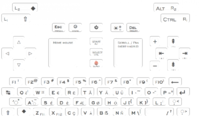1) I don't actually use Caps Lock myself, ever, nor do I use Shift Lock, ever. I DON'T UNDERSTAND WHY ANYONE WOULD NEED IT EXCEPT FOR SHOUTING. I would propose to let Shift+Shift be a user-configurable action: it could do either nothing at all, Caps Lock, or Shift Lock, or even something entirely different like Compose or whatever.I just have a couple small questions about this layout.My position/reasoning about the DosBox / US-QWERTY symbol pairs is as follows:
1. The software issues with DosBox are just software issues and can be solved.
2. Still, I think it makes sense to let the Pyra keyboard resemble one standard as closely as possible. US-QWERTY is a natural standard.
3. Shift+Meta is certainly possible (we want Shift-F-keys for example), but it is slightly less convenient than just one modifier.
4. Because of point 3, I prefer to have {}|:"?_+~<>!@#$%^&*() behind only one modifier (Shift if the unshifted key is available as a dedicated key, Meta otherwise), but because of point 2, I want the shifted symbols near the unshifted symbols so they still form pairs in a systematic way.
5. Duplicating the labels for the shifted symbols looks ugly and weird, and it feels wrong. There is nothing wrong with making Shift+/;'[]`-= produce the corresponding shifted symbols by default though.
I made yet another layout proposal in this spirit:
http://www.keyboard-layout-editor.com/#/layouts/16c6d036ba4e34ef2b8e3008c3c8cc89
1) Where you say "Shift+Shift: Caps Lock", would this invoke the real Caps-Lock key that exists on most full-size keyboards as a distinct key (and whose behavior differs from simply holding down shift) or is it simply making shift sticky? I think the former would be better as there doesn't appear to be a a caps-lock anywhere else. Perhaps Shift+Shift = real Caps-Lock key, and perhaps Meta+Shift+Shift = sticky Shift? Or would the latter be too strenuous?
2) What exactly does "eta lock" mean, where you wrote "Meta+Meta: eta Lock" ?
3) I really like the idea of the lid closed acting as Super being held down, allowing for media controls as mentioned in the layout. My only question is, would this cause the battery to drain quicker, as it would be like holding a key down for a long time. I'm not sure if that uses any more power than with no keys being held, or if the extra usage would simply be very negligible.
4) This is a very small thing. I noticed that you have PrtScn and SysRq as separate keys, and I wonder if that really is needed. On most keyboards that I've seen, the latter is the Shift (or is it Ctrl?) + the former. Maybe have the key labeled SysRq be Pause/Break instead, and maybe meta + that key be Scroll Lock?
Also, is SysRq actually used by something? I've noticed many layouts posted seem to put it in such upfront positions, so maybe there is something I don't know about regarding it.
Thanks.
2) Meta+Meta could be Meta Lock. Potentially useful if you're using an application that uses the F-keys a lot, for example. Again, could just be a user-configurable thing.
3) No, this would not cause the battery to drain. Holding down a button does not consume any noticeable power. The only thing that consumes a bit of power are input events (because they cause interrupts that keep the cpu from sleeping), so e.g. continuously moving the mouse or the nubs would cause power consumption to go a bit up (you can check this on your Pandora if you want). Keys only produce two events though: key down, and key up. This means holding down a button does not keep producing events by itself (although of course software could be programmed to let keys auto-repeat while held down, but those are timers set by software, not by the keyboard itself). So no reason to worry about this.
4) SysRq is used as the Magic SysRq key in Linux, but I guess it does not really need to be explicitly labeled, since people who can remember Magic SysRq combos can surely also remember the position of an unlabeled SysRq key somewhere. So yes, Scroll Lock or Pause could be added instead. None of those keys are really important though.
By the way, here is yet another of my proposals (sorry about the proposal spam), it's called "_wb_ international" in the big comparison table:
http://www.keyboard-layout-editor.com/#/layouts/01192fa1799361f7066da5897b76fb89





